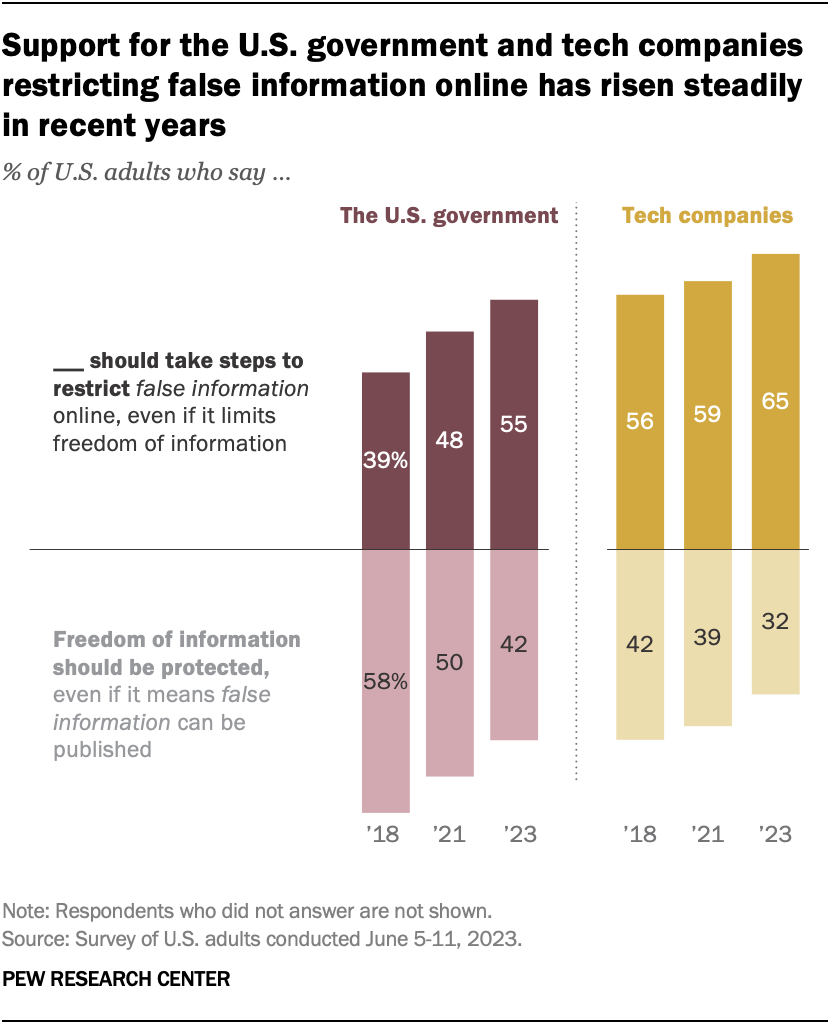Menu

Americans Are More Interested in Fighting Online False Information
Author:
Brad Berens
Date:
07/31/2023
New findings from the Pew Research Center show that Americans want the federal government and tech companies to do something about misinformation, but will they?
Last week, the Pew Research Center released intriguing new research findings that Americans are more worried about false information and violent content online today than they were just five years ago. Moreover, Americans support tech companies or the federal government doing something about false information online, although they are less comfortable with the government acting than the technology companies.
The tradeoff in Pew’s survey question is between the dangers of false information (which encompasses both misinformation and disinformation) and the dangers of limiting people’s freedom to publish or access information of any kind. More Americans are willing to make that trade.
As you’ll see in the image below, between 2018 and 2023 there’s a 16 percentage point increase in Americans’ openness to government acting and a 9 percentage point increase in Americans’ openness to technology companies taking action. Confidence in the technology companies has been higher than in the government (although that gap is shrinking).
Will the federal government or tech companies do anything? Probably not.
It’s encouraging to learn that Americans are more concerned about false information online. However, there’s little chance that either the federal government or tech companies will do much about it.
For the federal government, a first step would involve changing or throwing out Section 230 of the 1996 Communications Decency Act that insulated technology platforms from any liability from anything that users put onto those platforms. That’s unlikely. While there’s antipathy to Section 230 from both sides of the political aisle, Republicans and Democrats object to it for different reasons.
Other challenges include a divided legislature, well-heeled Big Tech lobbyists crowding every government hallway in Washington, D.C., and relatively few senators and representatives able to understand the complexities of the internet (demonstrated by their questions whenever someone like Meta’s Mark Zuckerberg or TikTok’s Shou Zi Chew testifies).
The tech companies are for-profit corporations that depend on ever-increasing user engagement to create more opportunities to put ads in front of those same users. False information drives outrage, which drives engagement, which in turn drives profits. The Tech Companies have no financial incentive to limit false information on their platforms.
Is there any hope?
Yes. Ad Fontes Media exists to provide such hope for its key stakeholders.
Citizens should learn to check their information sources before engaging with them and particularly before sharing news items with other people.
We have rated thousands of news sources and put them on our Media Bias Chart® so you can see for yourself how reliable and biased they are. Both the interactive version of the Media Bias Chart and the mobile app versions are easily searchable and transparently show the rating of each article that results in an aggregate score.
You can also do a little digging into a story that sounds outrageous by learning how to fact check by taking one of our Media Literacy courses, attending one of our free webinars, and by getting comfortable using free online resources like Snopes or PolitiFact.
Educators should explore our resources for teaching media literacy. Or, if you’re not ready to dive in, then join one of our free webinars. (Email education@adfontesmedia.com to learn more.)
Advertisers should take strong interest in Americans’ growing concerns about false information online and should carefully weigh where they spend their money. The wrong thing to do is stop advertising in the news altogether. The right thing to do is advertise in High Quality News, which is the highly reliable and minimally biased news in the green box at the top of the Media Bias Chart.
Advertising in High Quality News is also the smart thing to do because, as our recent Advertising Value of High Quality News report shows, people who consume High Quality News are generally healthier, wealthier, and better educated than their peers who consume Low Quality News. Most advertisers will find their best customers in High Quality News.
Ad Fontes provides data services for advertisers interested in getting the highest Return on Advertising Spend (ROAS) around news, which you can learn more about on our Data Platform page.
One good thing that could happen would be for combatting online false information to become an important voting issue as we accelerate toward the 2024 elections. The Pew findings that Americans are increasingly interested in this issue is an early sign that this might happen.



